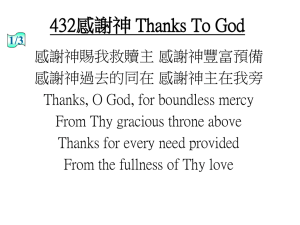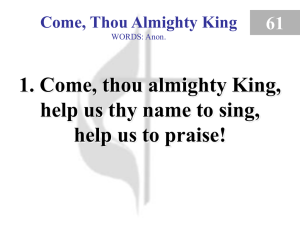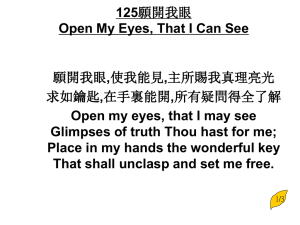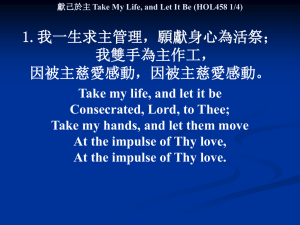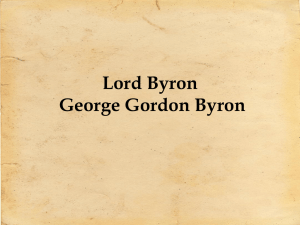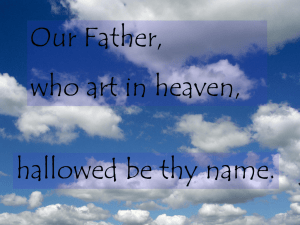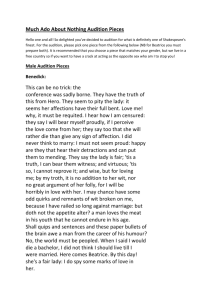Romantic - SOCSD Sites
advertisement
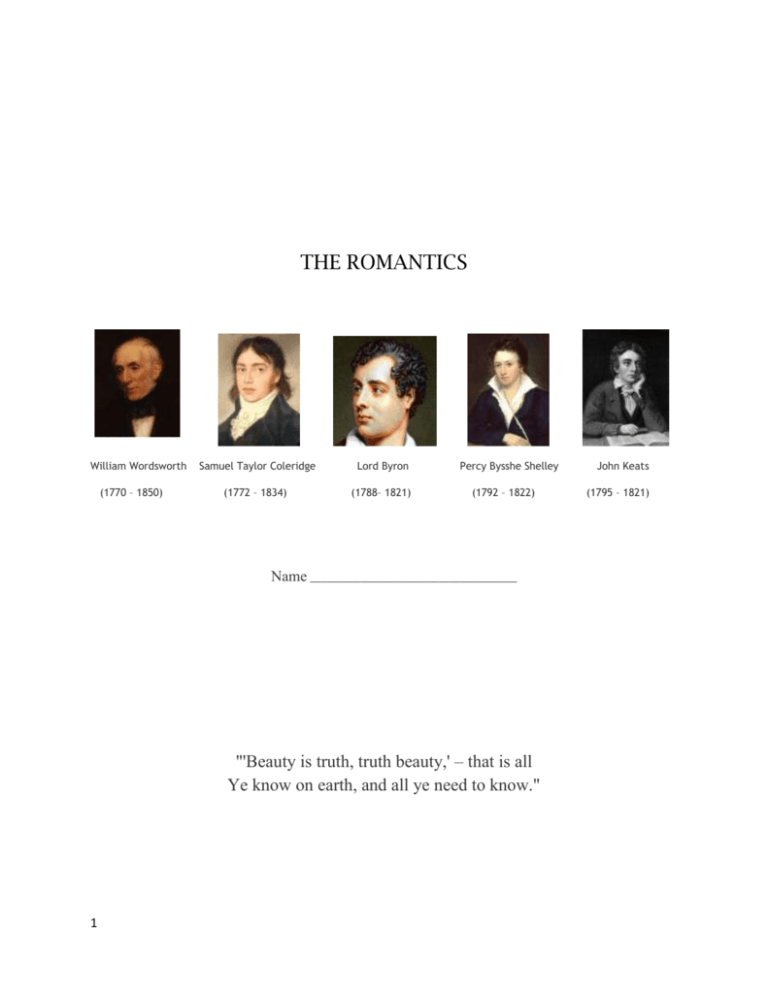
THE ROMANTICS William Wordsworth (1770 – 1850) Samuel Taylor Coleridge Lord Byron (1772 – 1834) (1788– 1821) Percy Bysshe Shelley (1792 – 1822) Name _____________________________________ "'Beauty is truth, truth beauty,' – that is all Ye know on earth, and all ye need to know." 1 John Keats (1795 – 1821) "Romantic" Class Cluster: Brainstorm words associated with “Romantic.” Which ideas/elements did you notice in the collection of songs? Songs include: “This Land is Your Land” “Puff, the Magic Dragon” “Both Sides Now,” “A Simply Twist of Fate,” and “Across the Universe.” Based on the above lists, what do you think Romanticism entails? 2 Background notes on Romanticism -late 18th-century/19th-century European literary movement -unlike the earlier Neoclassical writers, who favored reason and wit, the Romantic poets favored: *uniqueness of his own response to the world/history/nature *looking inward and examining his own emotional history *simplicity / directness of language *expression of spontaneous, intensified feelings *profound responses to nature (idea that contemplation of nature --> deeper awareness of self) -English Romanticism began with William Wordsworth. (the LYRIC - a poem in which a single speaker expresses personal emotions and observations) 3 The Quest for Beauty and Meaning "A thing of beauty is a joy forever: Its loveliness increases; it will never Pass into nothinginess." ~John Keats, from Endymion In their quest for beauty and meaning in art and in life, the Romantics embraced all aspects of existence—the sublime and the ordinary, the passionate and the serene, the transitory and the permanent. The Literary Sublime is an effect created when a writer confronts a power or mystery in nature that exceeds human understanding. It is achieved by representing the infinite or endless in sensory terms. Edmund Burke, who wrote Philosophical Inquiry into the Origin of Our Ideas of the Sublime and Beautiful (1756), identified the source of the sublime as "whatever is in any sort terrible […] that is, it is a productive of the strongest emotion which the mind is capable of feeling." Read the following excerpt from Lord Byron's "Apostrophe to the Ocean" and connect to the concept of the sublime. There is a pleasure in the pathless woods, There is a rapture on the lonely shore, There is society, where none intrudes, By the deep sea, and music in its roar: I love not man the less, but Nature more, From these our interviews, in which I steal From all I may be, or have been before, To mingle with the Universe, and feel What I can ne'er express, yet cannot all conceal. Roll on, thou deep and dark blue Ocean—roll! Ten thousand fleets sweep over thee in vain; Man marks the earth with ruin—his control Stops with the shore; upon the watery plain The wrecks are all thy deed, nor doth remain A shadow of man's ravage, save his own, When, for a moment, like a drop of rain, He sinks into thy depths with bubbling groan, Without a grave, unknelled, uncoffined, and unknown. And I have loved thee, Ocean! and my joy Of youthful sports was on thy breast to be Borne, like thy bubbles, onward: From a boy I wantoned with thy breakers—they to me Were a delight; and if the freshening sea Made them a terror—'twas a pleasing fear, For I was as it were a child of thee, And trusted to thy billows far and near, And laid my hand upon thy mane—as I do here. 4 Dates Thursday, 12/4 Discussions, Assignments, and Poetry Presentations Introduction to Romanticism and the Sublime Wordsworth – "The Daffodils" HW: 1. Study your assigned poem and answer questions 2. Read/annotate “Kubla Khan” and answer questions -“The Daffodils” Monday, 12/8 -Coleridge – "Kubla Khan" - Introduction – the Byronic Hero Tuesday, 12/9 *Time to plan group poetry presentations HW: Song Analysis Paragraph Due: Song Analysis Wednesday, 12/10 Byron – "My Soul is Dark" (Conor, Joanna, Vincent) Byron – "She Walks in Beauty" (Bailey, Bri, Yuna) Byron – "When We Two Parted" (Christian, Christine, Margaret) Thursday, 12/11 Friday, 12/12 Shelley – "Ozymandias" (Ally, Gigi, Kaila) Keats – "Bright Star" (Alex, Justina, Kelly) Keats—"When I Have Fears that I May Cease to Be" (Jake, Sara, Stephanie) -Lab – 205 to work on digital credos / Guilty Pleasure Response HW: 1. Review Romanticism notes / poems in preparation for essay 2. Complete Guilty Pleasure Journal (due Mon.) 3. Digital Credo due Wed. Keats – "Ode on a Grecian Urn" (Amanda, Andrew, Collin, Lulu) Monday, 12/15 Romantics – Quiz In-class timed New Paltz Essay Tuesday, 12/16 Wednesday, 12/17 -Portfolio Checkpoint #1 -Share digital credos -Introduction to Night Thursday, 12/18 Lab – 205 Portfolio Writing/ Organization /Revision Friday, 12/19 Read-aloud HW over holiday break: 1. Work on Senior Portfolio 2. Night - see Night packet for assignments and due dates 5 The Daffodils by William Wordsworth I wandered lonely as a cloud That floats on high o'er vales and hills, When all at once I saw a crowd, A host, of golden daffodils; Beside the lake, beneath the trees, Fluttering and dancing in the breeze. Continuous as the stars that shine And twinkle on the Milky Way, They stretched in never-ending line Along the margin of a bay: Ten thousand saw I at a glance, Tossing their heads in sprightly dance. The waves beside them danced, but they Out-did the sparkling waves in glee: A Poet could not but be gay, In such a jocund company: I gazed—and gazed—but little thought What wealth the show to me had brought: For oft, when on my couch I lie In vacant or in pensive mood, They flash upon that inward eye Which is the bliss of solitude; And then my heart with pleasure fills, And dances with the daffodils. 6 Kubla Khan by Samuel Taylor Coleridge In Xanadu did Kubla Khan A stately pleasure dome decree: Where Alph, the sacred river, ran Through caverns measureless to man Down to a sunless sea. So twice five miles of fertile ground With walls and towers were girdled round: And there were gardens bright with sinuous rills, Where blossomed many an incense-bearing tree; And here were forests ancient as the hills, Enfolding sunny spots of greenery. But oh! that deep romantic chasm which slanted Down the green hill athwart a cedarn cover! A savage place! as holy and enchanted As e'er beneath a waning moon was haunted By woman wailing for her demon lover! And from this chasm, with ceaseless turmoil seething, As if this earth in fast thick pants were breathing, A mighty fountain momently was forced: Amid whose swift half-intermitted burst Huge fragments vaulted like rebounding hail, Or chaffy grain beneath the thresher's flail: And 'mid these dancing rocks at once and ever It flung up momently the sacred river. Five miles meandering with a mazy motion Through wood and dale the sacred river ran, Then reached the caverns measureless to man, And sank in tumult to a lifeless ocean: And 'mid this tumult Kubla heard from far Ancestral voices prophesying war! The shadow of the dome of pleasure Floated midway on the waves; Where was heard the mingled measure From the fountain and the caves. It was a miracle of rare device, A sunny pleasure-dome with caves of ice! A damsel with a dulcimer In a vision once I saw; It was an Abyssinian maid, And on her dulcimer she played, Singing of Mount Abora. Could I revive within me Her symphony and song, To such a deep delight 'twould win me, That with music loud and long, I would build that dome in air, That sunny dome! those caves of ice! And all who heard should see them there, And all should cry, Beware! Beware! His flashing eyes, his floating hair! Weave a circle round him thrice, And close your eyes with holy dread, For he on honey-dew hath fed, And drunk the milk of Paradise. 7 Questions 1. Describe the pleasure dome and its setting. 2. Compare the associations of the "deep romantic chasm" with those of the dome. 3. What makes the pleasure dome and its setting seem beautiful? What makes them sinister? 4. What comes from the chasm, and what are its effects? 5. In the last stanza, if the speaker were able to "revive" his vision, what would he do? What effect would it have on "all who heard"? 6. What does the "holy dread" experienced by "all who heard" suggest about the power of art? 7. What connection can you find between this "dread" and the existence of the chasm at the site of the dome? 8. Consider a work of art that has had a strong effect on you. Do you think your experience of this work supports Coleridge's views? Explain. 8 THE BYRONIC HERO - "Mad, bad, and dangerous to know."1 George Gordon, Lord Byron gave his name to a hero that is "devastatingly attractive yet fatally flawed." The Byronic hero represents a model of reckless, wounded manhood—"a man proud, moody, cynical, with defiance on his brow, and misery in his heart, a scorner of his kind, implacable in revenge, yet capable of deep and strong affection."2 Notes: THE LURE OF THE GOTHIC The Romantic period's literature is filled with eerie and supernatural elements. The Romantics' taste for terror grew from "the Gothic Romance," a story set in a gloomy, medieval castle. Notes: 1 2 Lady Caroline Lamb spoke these words describing Lord Byron. stated by Thomas Babington Macaulay 9 My Soul is Dark by Lord Byron My soul is dark - Oh! quickly string The harp I yet can brook to hear; And let thy gentle fingers fling Its melting murmurs o'er mine ear. If in this heart a hope be dear, That sound shall charm it forth again: If in these eyes there lurk a tear, 'Twill flow, and cease to burn my brain. But bid the strain be wild and deep, Nor let thy notes of joy be first: I tell thee, minstrel, I must weep, Or else this heavy heart will burst; For it hath been by sorrow nursed, And ached in sleepless silence, long; And now 'tis doomed to know the worst, And break at once - or yield to song. Questions 1. Why is this poem considered a Romantic Gothic piece? 2. Write a theme for this poem, and support it with textual evidence. 10 She Walks in Beauty by Lord Byron She walks in beauty, like the night Of cloudless climes and starry skies; And all that's best of dark and bright Meet in her aspect and her eyes: Thus mellowed to that tender light Which heaven to gaudy day denies. One shade the more, one ray the less, Had half impaired the nameless grace Which waves in every raven tress, Or softly lightens o'er her face; Where thoughts serenely sweet express How pure, how dear their dwelling place. And on that cheek, and o'er that brow, So soft, so calm, yet eloquent, The smiles that win, the tints that glow, But tell of days in goodness spent, A mind at peace with all below, A heart whose love is innocent! Questions 1. Do you think the speaker idealizes the subject of "She Walks in Beauty"? Explain. 2. To what does the speaker compare the lady's beauty? What might "that tender light" in line 5 be? 3. What would have "half impaired" the lady's grace? What does this claim suggest about the lady's beauty? 4. In lines 11-18, what is the woman's appearance said to reveal about her character? How is the focus of the last six lines different from the focus of the opening lines? 5. Does Byron's portrayal emphasize the spiritual or the physical aspect of the lady? Explain. 6. Do you agree that goodness is an inherent part of beauty? Explain. 11 When We Two Parted by Lord Byron When we two parted In silence and tears, Half broken-hearted To sever for years, Pale grew thy cheek and cold, Colder thy kiss; Truly that hour foretold Sorrow to this. The dew of the morning Sunk chill on my brow-It felt like the warning Of what I feel now. Thy vows are all broken, And light is thy fame; I hear thy name spoken, And share in its shame. They name thee before me, A knell to mine ear; A shudder comes o'er me-Why wert thou so dear? They know not I knew thee, Who knew thee too well-Long, long shall I rue thee, Too deeply to tell. In secret we met-In silence I grieve, That thy heart could forget, Thy spirit deceive. If I should meet thee After long years, How should I greet thee?-With silence and tears. Questions 1. What is the tone of this piece? Support with specific quotes. 2. What does the repetition of the phrase "silence and tears" suggest about the speaker's state? 3. How does the imagery of this poem contribute to the poet's purpose? Be specific. 12 Ozymandias by Percy Bysshe Shelley I met a traveller from an antique land Who said: "Two vast and trunkless legs of stone Stand in the desert . . . Near them, on the sand, Half sunk, a shattered visage lies, whose frown, And wrinkled lip, and sneer of cold command, Tell that its sculptor well those passions read Which yet survive, stamped on these lifeless things, The hand that mocked them, and the heart that fed: And on the pedestal these words appear: 'My name is Ozymandias, king of kings: Look on my works, ye Mighty, and despair!' Nothing beside remains. Round the decay Of that colossal wreck, boundless and bare The lone and level sands stretch far away." Questions 1. What sight does the traveler describe? What overall effect does this sight have? 2. How would you describe the expression on the face of Ozymandias? What does his expression suggest about the kind of ruler he was? 3. What attitude is conveyed by the words on the pedestal? Compare this attitude with the opening images of the poem. In what sense is the inscription ironic? 4. What is the message of this poem? Is it pertinent to today's world? Explain. 13 Bright Star by John Keats Bright star! would I were steadfast as thou art— Not in lone splendour hung aloft the night, And watching, with eternal lids apart, Like Nature's patient sleepless Eremite, The moving waters at their priestlike task Of pure ablution round earth's human shores, Or gazing on the new soft fallen mask Of snow upon the mountains and the moors— No—yet still steadfast, still unchangeable, Pillow'd upon my fair love's ripening breast, To feel for ever its soft fall and swell, Awake for ever in a sweet unrest, Still, still to hear her tender-taken breath, And so live ever—or else swoon to death. Questions 1. How is the atmosphere of warmth and peacefulness in the final six lines (sestet) contrasted with the atmosphere of remoteness, coldness, and lack of involvement in the first eight lines (octave)? 2. Discuss the significance of the mention of death in the last line. 3. What does the lover have that the star does not? 14 When I Have Fears that I May Cease to Be by John Keats When I have fears that I may cease to be Before my pen has glean’d my teeming brain, Before high piled books, in charact’ry, Hold like rich garners the full-ripen’d grain; When I behold, upon the night’s starr’d face, Huge cloudy symbols of a high romance, And think that I may never live to trace Their shadows, with the magic hand of chance; And when I feel, fair creature of an hour! That I shall never look upon thee more, Never have relish in the faery power Of unreflecting love!—then on the shore Of the wide world I stand alone, and think Till Love and Fame to nothingness do sink. Questions 1. In lines 1-4, what does the speaker fear he will not accomplish before he dies? 2. In lines 5-12, what is the speaker concerned about missing? 3. Do the last lines offer a convincing resolution to the speaker's fears? Explain. 4. Describe Keats's character as revealed in this poem. 15 Ode on a Grecian Urn by John Keats Thou still unravish'd bride of quietness, Thou foster-child of Silence and slow Time, Sylvan historian, who canst thus express A flowery tale more sweetly than our rhyme: What leaf-fringed legend haunts about thy shape Of deities or mortals, or of both, In Tempe or the dales of Arcady? What men or gods are these? what maidens loth? What mad pursuit? What struggle to escape? What pipes and timbrels? What wild ecstasy? Heard melodies are sweet, but those unheard Are sweeter; therefore, ye soft pipes, play on; Not to the sensual ear, but, more endear'd, Pipe to the spirit ditties of no tone: Fair youth, beneath the trees, thou canst not leave Thy song, nor ever can those trees be bare; Bold lover, never, never canst thou kiss, Though winning near the goal--yet, do not grieve; She cannot fade, though thou hast not thy bliss, For ever wilt thou love, and she be fair! Ah, happy, happy boughs! that cannot shed Your leaves, nor ever bid the Spring adieu; And, happy melodist, unwearied, For ever piping songs for ever new; More happy love! more happy, happy love! For ever warm and still to be enjoy'd, For ever panting, and for ever young; All breathing human passion far above, That leaves a heart high-sorrowful and cloy'd, A burning forehead, and a parching tongue. Who are these coming to the sacrifice? To what green altar, O mysterious priest, Lead'st thou that heifer lowing at the skies, And all her silken flanks with garlands drest? What little town by river or sea shore, Or mountain-built with peaceful citadel, Is emptied of this folk, this pious morn? And, little town, thy streets for evermore Will silent be; and not a soul to tell Why thou art desolate, can e'er return. O Attic shape! Fair attitude! with brede Of marble men and maidens overwrought, With forest branches and the trodden weed; Thou, silent form, dost tease us out of thought As doth eternity: Cold pastoral! When old age shall this generation waste, Thou shalt remain, in midst of other woe Than ours, a friend to man, to whom thou say'st, 'Beauty is truth, truth beauty'--that is all Ye know on earth, and all ye need to know. 16 Questions 1. Describe the scenes in stanzas I and II. 2. Why might the lover in stanza II grieve? Why does the speaker advise him not to grieve? 3. Which items are called "happy" in stanza III? What is the reason for their happiness? 4. What do the speaker's comments on these painted scenes indirectly suggest about real life? 5. Based on the final stanza, what is the "'truth'" represented by the scenes on the urn? 6. Is the truth of the urn the "whole truth"? Explain. 17 Group Poetry Presentations Your Task: Read, analyze and discuss your assigned poem. Then, plan a group presentation (7 – 10 minutes) in which you teach the poem to the class. See page five of this packet for due dates. Your presentation must include: 1. a read-aloud of the poem 2. a discussion of literary elements/techniques (how do they develop the theme?) 3. your analysis and interpretation of the poem 4. annotations (on Smartboard) 5. connections to your world (how/why is this relevant today?) **ON WEDNESDAY, DECEMBER 10th, EACH GROUP MUST SUBMIT THREE ORIGINAL MULTIPLE CHOICE QUESTIONS BASED ON ITS ASSIGNED POEM. Presentation Rubric In-depth coverage of topic Were the important points of the poem fully addressed and delivered in a thorough and meaningful way? Effective support of ideas through quotes and other specific references Was the group's analysis supported through textual examples? Did the group members include annotations? Planning of presentation Was there evidence that the group spent time in planning and preparing the presentation? Group collaboration and effort Did the group work effectively together during class time? Participation of all group members in presentation Was everyone in the group involved in speaking and presenting to the class? Relevance to your world Did the group discuss how the poem applies to today’s society? Appropriate voice projection and eye contact Did the presenters address the class effectively? Multiple Choice Questions Did the group submit three printed m/c questions based on poem? 18 Excellent 90-100 Good 80-89 Fair 70-79 Poor 69 and below 19
